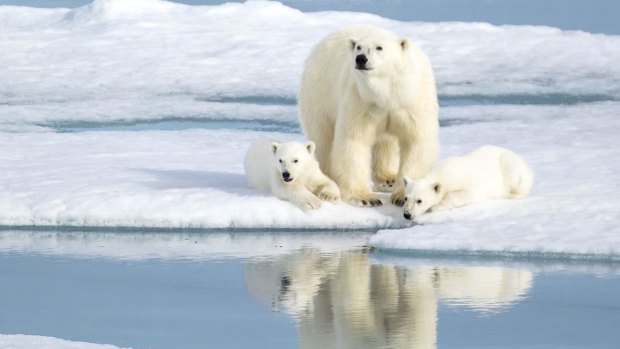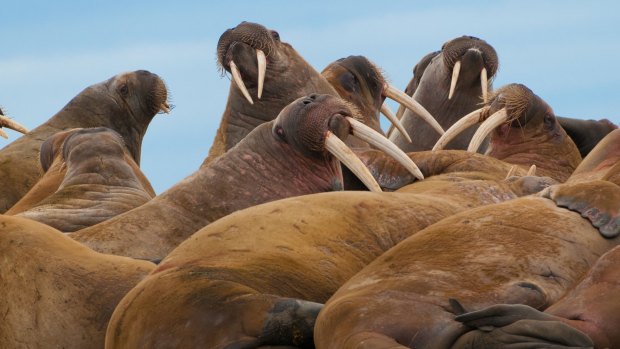By Jamie Lafferty

A mother bear keeping watch over her two cubs in the Norwegian Arctic.Credit: Shutterstock
Bears are fierce; bears are cautious. Bears are solitary; bears, the females at least, are dedicated to family. Bears are omnipotent; bears are vulnerable. They are everything we want to be and everything we cannot abide … those are a lot of conflicting human characteristics to project onto another species, especially when we are so ill-equipped to handle them ourselves.
Seeing a polar bear in the wild stirs up all manner of profound thoughts, but right now, this polar bear, the one just a few hundred metres in front of us, is indisputably, unequivocally, yawning. To the passengers of One Ocean Expedition's Akademik Sergey Vavilov, this is a surprise. Not the sight of its deadly teeth, or the way the sunlight catches the powerful jaw muscles, but the fact we're only seeing them because the master predator has grown sleepy. We have been watching the bear intently for two hours – watching it while it watches a seal's breathing hole on the surface of some soon-to-be melted fast ice in the gorgeous Palanderbukta fiord. This is on the coast of Nordaustlandet, one of the Norwegian islands that make up the Svalbard archipelago.
The atmosphere on-board has hitherto been anything but soporific. People are afraid to eat or go to the toilet for fear they'll miss out on some action. In the far distance, two absurdly cute polar bear cubs cuddle each other, intertwined like little white clouds. What if they come in to suckle? What if their mother disembowels a ring seal and feeds it to them? What if? What if?

A group of large walrus on the beach in Lagoya.Credit: Shutterstock
What if … the polar bear falls asleep? No one had been ready for that. "You wanted to be wildlife photographers? Well this is it folks," says the ship's photographer-in-residence Boomer Jerritt in a sort of shouted whisper so as not to disturb the bear.
As the mighty hunter drifts in and out of consciousness like a grandmother on a turgid Christmas Day, a sort of madness seems to befall the passengers of the Vavilov. Many are photographers with high-end kit, so when the bear looks to the left, dozens of camera shutters flutter like frightened birds. A billion megapixels record the moment. The bear looks to the right. A billion more. It yawns. Two billion.
For nine hours this game of cat-without-mouse continues until, having spent the entire day essentially idle, the mother bears walks off into the great cold beyond, two little fluffy heartbreakers following in her white wake.
This isn't our only encounter with polar bears in the Norwegian High Arctic, but it is certainly our longest and undoubtedly the most tedious. Not that anyone complains, not in any meaningful way. Ursus maritimus is after all the rock star that most of the 81 passengers aboard the Vavilov had come to see during the nine nightless days of the Spitsbergen Encounter programme put together by One Ocean. Merciful weather and the brilliant eyes of the casually heroic expedition staff help us spot seven other bears during the trip, though at least one of those certainly saw us first, before swimming a couple of kilometres out to inspect the ship like the apparition of a drowned coastguard.
The presentation room, buried deep on the first deck of the ship, is where the staff give lectures on ice, bears and other fauna during the scarce downtime we have during the expedition. Inevitably, some of these talks include apocalyptic visions of our freakishly hot future. It can be hard to learn these lessons while the environment undergoes this invisible disintegration just outside the porthole, but perhaps there's no better place to get ready for what's to come. Even so, when I step back out into weather that's 10 degrees hotter than it should be, or see a house-sized piece of ice fall from glacier face, the Arctic appears wounded rather than going through a natural cycle.
On a less globally cataclysmic level, the plight of the polar bear is easier to understand. As 2018 continues to thrash temperature records and the extent and duration of the sea ice is reduced, so the bears lose their platforms for hunting seals. Some have begun to adapt, raiding some of Svalbard's chaotic, abundant seabird colonies for eggs, but that's a lot of omelette before you've eaten a seal's worth of calories.
Elsewhere, reindeer are indigenous and have enjoyed many thousands of years without any serious predation, aside from those harvested by Jack Frost every winter. However, like almost everything in this fragile ecosystem, that is now subject to change. In their growing desperation for food, polar bears have begun to hunt the deer and while they are mostly reduced to attempting to snatch the old, sick or very young, there's no questioning their will to save themselves, despite mankind's efforts to the contrary.
For now, the polar bear still dominates most minds, on Svalbard and on the Vavilov. One evening during one of the ship's "fireside talks" kayak instructor Jaime Sharp tells the passengers of his epic 76-day paddle around the islands. It was a world-first, completed with two others in unimaginable conditions. "We'd entered the kingdom of the bear … we'd entered the kingdom," he says, sounding just a little haunted by the memory. Nights were spent either camping on ice cliffs or moraine beaches, sleeping in shifts before epic paddles that could last more than 20 hours. Inevitably, polar bears were also a significant factor. The group averaged seeing one every other day, of which perhaps eight were looking for dinner invites. Mercifully, for man and beast alike, the bear bangers, warning shots and prodigious amounts of loud swearing were always just enough to scare them away.
There's an easy argument to make that they should never have put themselves in such lunatic danger. Bears aside, there's very little tapering along the Svalbardian coastline; this is not a gentle place – the landscape matches the climate, which is to say it is brutal and hints strongly that humans should not live here.
Yet there's beauty in this barbarism, too. The magnificent sea cliffs of Vibebukta look as though they've been rejected by the Game of Thrones set designers for being a bit too fanciful. By contrast, they've been embraced by 60,000 breeding pairs of clumsy Brunnich's guillemot, which look as though they're flying for the first time every time.
On the higher floors of this bird city, an arctic fox goes about his villainous business with ruthless intent. One other bright morning, during a landing at Bellsund, I find myself alone with one, its keen marble eyes occasionally checking on me between naps. The time I spend in his (or her) company constitutes one of those magic polar moments that seem to only happen at the ends of the earth. For a murderous little scavenger, the Arctic fox is a cute little bugger.
The same cannot be said for the walrus, whose bloated frames and overwhelming odour we encounter more than once. These illiterate, unwashed masses glide effortlessly through the water, but each beaching is a significant event. As one large bull returns to the pungent embrace of his brothers, he's met with gurgling protest, the air filling with tusks and flatulence.
The only other grumbling I hear all week comes from a couple of human pensioners who, I have to assume, have been made miserable by their outrageous existential and financial fortunes. Their complaints? That the expedition staff are too happy – too upbeat. On the last night, during the captain's dinner I briefly gaze past one of these lovely blue-shirted Arctic babysitters and out through a porthole on the starboard side. Behind, in the kingdom of the polar bear, evening sun dapples a glacier face while clouds envelope mountain tops like Cossack hats, and I have to believe that if I worked here, I'd be pretty cheery as well.
WHERE TO SEE FIVE OTHER APEX PREDATORS
GREAT WHITE SHARKS
The world's most easily visited population of great white sharks is located off the coast from Gansbaai, a few hours outside of Cape Town, South Africa
ASIATIC LIONS
African lions are found easily enough, not so for the incredibly endangered Asiatic lions, just 600 of which are found in north-west India.
BENGAL TIGERS
A healthy population of Bengal tigers can be found in the southerly national parks of Nepal, including Royal Chitwan and Bardia.
GRIZZLY BEARS
It's considerably easier to spot grizzly bears than their albino counterparts, but nowhere are they more readily found than in Alaska.
SPIRIT BEARS
Slightly further to the south you'll find another ursine option – British Columbia is home to one of the healthiest populations of spirit bear.
TRIP NOTES
Emirates, Qantas, and Qatar all fly to Athens from Sydney and Melbourne via their hubs in the Middle East. See emirates.com qantas.com.au qatarairways.com From Athens, fly Norwegian (norwegian.com) to get to Longyearbyen on Svalbard.
CRUISE
Polar specialists One Ocean Expeditions run Arctic and Antarctic cruises, including the nine-night Spitsbergen Encounter programme. While polar bear sightings are not guaranteed, they are highly likely. See oneoceanexpeditions.com
Sign up for the Traveller Deals newsletter
Get exclusive travel deals delivered straight to your inbox. Sign up now.